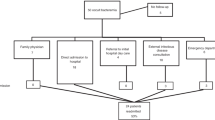Abstract
A prospective study was carried out to analyze the usefulness of blood culture results for adult patients who were discharged from the emergency department with bacteremia. Over a 29-month period, 110 patients with significant bacteremia who were seen in the emergency department and discharged home were studied. The mean age of the patients was 61.8 years. The most frequent initial major diagnosis was urinary tract infection (UTI) (n=63; 57.3%). Gram-negative organisms were isolated in 79 (71.8%) cases. A change in diagnosis (44.5% cases) was more common when the initial diagnosis was something other than UTI or when empiric antimicrobial therapy was ineffective or was not given (P<0.001). The significant predictors of modification of the initial empiric antibiotic therapy were ineffective empiric antimicrobial therapy and transfer of the patient from the emergency department to an infectious diseases outpatient clinic (P=0.01). Blood culture results may be useful for achieving the correct diagnosis in adult patients with bacteremia and for guiding treatment in the subsequent management of outpatients.
Similar content being viewed by others
References
Marco CA, Schoenfeld CN, Hansen KN, Hexter DA, Stearns DA, Kelen GD (1995) Fever in geriatric emergency patients: clinical features associated with serious illness. Ann Emerg Med 26:18–24
Talan DA (1996) Infectious disease in the emergency department. Clin Infect Dis 23:1–14
Weinstein MP (1996) Current blood culture methods and systems: clinical concepts, technology, and interpretation of results. Clin Infect Dis 23:40–46
Alpern ER, Alessandrini EA, Bell LM, Shaw KN, McGowan KL (2000) Occult bacteremia from a pediatric emergency department: current prevalence, time to detection, and outcome. Pediatrics 106:505–511
Epstein D, Raveh D, Schlesinger Y, Rudensky B, Gottehrer NP, Yinnon AM (2001) Adult patients with occult bacteremia discharged from the emergency department: epidemiological and clinical characteristics. Clin Infect Dis 32:559–565
Sturmann KM, Bopp J, Molinari D, Akhtar S, Murphy J (1996) Blood cultures in adults patients released from an urban emergency department: a 15-month experience. Acad Emerg Med 3:768–775
Tudela P, Queralt C, Giménez M, Carreres A, Tor J, Sopena N, Valencia J (1998) Detection of bacteremia in patients discharged from an emergency unit: study of 61 cases. Med Clin (Barc) 111:201–204
Javaloyas M, Jarné J, García D, Gudiol F (2001) Bacteremia in patients discharged from the emergency unit. Med Clin (Barc) 116:692–693
Mellors JW, Horwitz RI, Harwey MR, Horwitz SM (1987) A simple index to identify occult bacterial infection in adults with acute unexplained fever. Arch Intern Med 147:666–671
Leibovici L, Cohen O, Wysenbeek AJ (1990) Occult bacterial infection in adults with unexplained fever. Validation of a diagnostic index. Arch Intern Med 150:1270–1272
Stalnikowicz R, Block C (2001) The yield of blood cultures in a department of emergency medicine. Eur J Emerg Med 8:93–97
Sklar DP, Rusnak R (1987) The value of outpatient blood culture in the emergency department. Am J Emerg Med 5:95–100
Eisenberg JM, Rose JD, Weinstein AJ (1976) Routine blood cultures from febrile outpatients: use in detecting bacteremia. J Am Med Assoc 236:2863–2865
Fontanarosa PB, Kaeberlein FJ, Gerson LW, Thomson RB (1992) Difficulty in predicting bacteremia in elderly emergency patients. Ann Emerg Med 21:842–848
Gur H, Aviram R, Or J, Sidi Y (2003) Unexplained fever in the ED: analysis of 139 patients. Am J Emerg Med 21:230–235
Acknowledgments
We thank the staff of the emergency department and the microbiology department of the Hospital General Universitario de Elche for their help in this study.
Author information
Authors and Affiliations
Corresponding author
Rights and permissions
About this article
Cite this article
Ramos, J.M., Masiá, M., Elía, M. et al. Epidemiological and clinical characteristics of occult bacteremia in an adult emergency department in Spain: influence of blood culture results on changes in initial diagnosis and empiric antibiotic treatment. Eur J Clin Microbiol Infect Dis 23, 881–887 (2004). https://doi.org/10.1007/s10096-004-1235-0
Published:
Issue Date:
DOI: https://doi.org/10.1007/s10096-004-1235-0




